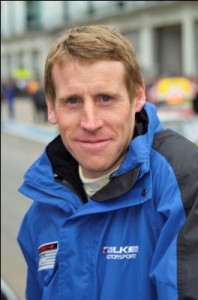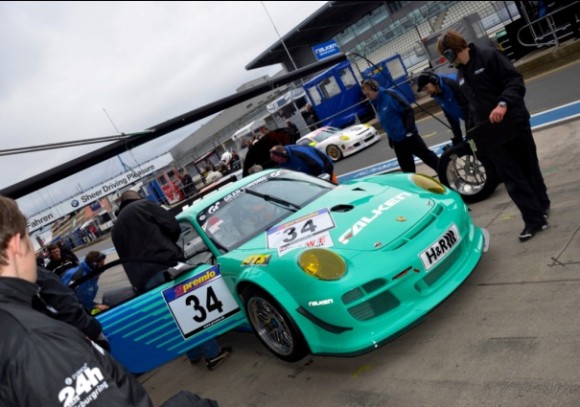9 Magazine presents an Interview with Peter Dumbreck after his first race and tire test of FALKEN’s new Porsche 997GT3 R. Peter will be racing the car in this year’s Nürburgring 24 Hour race. After a successful result in a Nissan last year, the new Porsche offers the team a chance for a strong finish.
 Dumbreck began his motorsport career in 1986 in karting. In 1996, he claimed the British Vauxhall Lotus Series. In F3, Dumbreck scooped the prestigious Macau Grand Prix before moving on to factory Mercedes and Opel drives in the DTM. Dumbreck has subsequently competed in the Japanese GT Series, Le Mans Series and this year is driving in the GT1 World Championship in a Nissan GTR.
Dumbreck began his motorsport career in 1986 in karting. In 1996, he claimed the British Vauxhall Lotus Series. In F3, Dumbreck scooped the prestigious Macau Grand Prix before moving on to factory Mercedes and Opel drives in the DTM. Dumbreck has subsequently competed in the Japanese GT Series, Le Mans Series and this year is driving in the GT1 World Championship in a Nissan GTR.
Peter, you are well known for racing Japanese cars, notably the Nissan GTR in the GT1 championship, but is this your first time racing a Porsche?
PD – No, I’ve driven a few Porsches earlier in my career including the Alzen 996 Turbo and 996 and 997 Cup cars in the Carrera Cup six or seven years ago. I’ve also driven an older RSR at the Nurburging in 2005
How does FALKEN’s new 997 compare to the other Porsches?
PD – This car is so user friendly. Porsche know how to build race cars for every level of GT racing and this one is packed with features to enable a breadth of drivers to get the maximum out of it. We have an adjustable seat and steering wheel making it easy for all of us to get comfortable and theres four of us sharing the car in the 24 hour race. There is traction control, ABS and tyre pressure monitoring too. The latter is vital at the Nordschleife and during testing I got advanced warning of a slow puncture and was able to return the car safely to the pits. With a 26km lap, having the data around you is essential.
 What are your impressions after driving the car?
What are your impressions after driving the car?
PD – Very driver friendly and predictable. The rear is very stable even over some of the jumps. I looked down at Flugplatz to see we are doing over 200km/h, that’s quick enough through there and the car feels good. The ABS is also really good; it’s subtle and really inspires confidence. For less experienced drivers it enables you to go harder into the corner, something that’s important in the Porsche. You can flat shift with the sequential box too, with an auto blip on downshifts, it all helps and prevents risks of locking the rears or miss-shifting.
Does the Porsche require a different style then?
PD – I find trail braking is a good way to carry speed into the car without upsetting the balance. There is a lot of weight over the rear and whilst we have exceptional grip with the large rear tyres (330mm wide), with the Porsche you need to brake deeper and commit to the apex before getting hard on the power. I’m finding oversteer is neutralised with the traction control and this enables us to get good lap times. I’ve also recently done track day tuition in 997s in the UK and there are similarities to the road 997 and using this technique to improve lap times.
So is the Porsche much quicker than the Nissan Z used last year?
PD – We are not far off 40 seconds quicker than the Nissan last year so the pace is there with this car and our latest tyre. This was backed up by Jorg Bergmeister, my team mate and factory driver who, at the first round, qualified 6th. Top speed is around 280km/h so it’s quick!
The Nurburgring race is different to Le Mans. As someone highly experienced in both, what are your observations?
PD – Nürburgring is a more much relaxed and fun event than Le Mans. The atmosphere is much more friendly and the fans in the forest are night seem to have a good time. From the racing side, our car should be right at the sharp end of the grid so me dealing with traffic is very different to my recent races in the GT2 Spyker. At Le Mans, the prototypes can be double our speed and you are constantly wary of them whereas at Nürburgring, it’s the Clios and older cars that we have to thread our way by. With around 200 cars on track, it can be busy and nowadays with many factory cars the pace is hot so we have to be on it from the start.
I think it is more of a family event too and it’s great they have kept the atmosphere as it has grown. They are also keeping things fair between the professional teams and the amateurs too. For instance, we all have to queue for pump fuel which is dispensed at similar rate to a regular petrol station. So we can be queuing there but it means there is less rush for putting belts on and getting settled in the car.
Because you have four drivers per car, we also have more breaks and the team gets us a container with bunks inside to sleep in. I’ll manage to get some sleep in the night without too much trouble.
Do you know the ‘Ring well?
PD – Yes, I do. I’ve done it in 03 and 04 in a DTM Opel car and also 05 in a Porsche with Alzen and 07,08,09 and 10 with FALKEN in the Nissan. There are some people that specialise in the Ring and drive many laps in the VLN. These guys have incredible knowledge but only know this track. I tend to build up confidence and the speed. I have a good knowledge of how the track changes and feels and use this to carry the speed through the weekend.
Do you have a favorite section?
PD – From Hohe Acht on is pretty special, it’s very quick there. I also like Pflanzgarten, which is cool too.
You’ve also been doing tire testing with FALKEN, tell us a little about that?
PD – This is the first year FALKEN has run a Porsche and they needed to develop new tires to get the most from the 997. The Porsche is very different to the front engine, rear drive Nissan so this has to be factored into the construction. In addition, FALKEN’s experienced engineers have been analysing the track surface and composition to offer the required grip. Its engineers are highly experienced and know how to build a durable, consistent tyre, something that is essential in such a race. FALKEN has an exceptional heritage at the circuit and each year we get better and better. I also know this knowledge is used by the road car engineers so it’s unsurprising their performance tyres such as the FK452 are widely used on track days. Our demands for a consistent tyre with good turn in and responsiveness are things that are equally relevant for this and the road.
So do you have a wide choice of tires?
PD – We used our last test to fix the compounds and FALKEN is already starting to produce the tires for the race in June. We’ll have multiple compounds including a softer one for the cooler night stints as well as inters and wets – the weather is changeable! The engineers from Japan know how to make a good race tire and with the ALMS programme, also with a Porsche though GT2 spec, they were rapidly able to define a core compound and construction that was great from the off. The tires remained consistent during long run testing and very user friendly without any snap oversteer which can be very difficult on tracks like the Nordscheife. That’s another advantage we have.
Have you also looked at set up?
PD – A little but it’s important that you have a base set up before doing the tyre work and fixing the compounds. Having factory drivers such as Jorg Bergmeister and Wolf Henzler mean we are good shape and both of those highly experienced Porsche drivers feel the car is good and we can refine set up in our next run.
How will you split the race with your team mates?
PD – We can’t be in the car for more than two and a half hours, that’s a rule there. We’ll do longer runs, probably two stints of 8 laps. We have a strong line up with factory drivers including Henzler, Ragginger and Asch, and the team FALKEN has set up has extensive Porsche experience but its a long race with many variables so we’ll see.
Thank you
PD – Thank you
Source: Propel Technology




